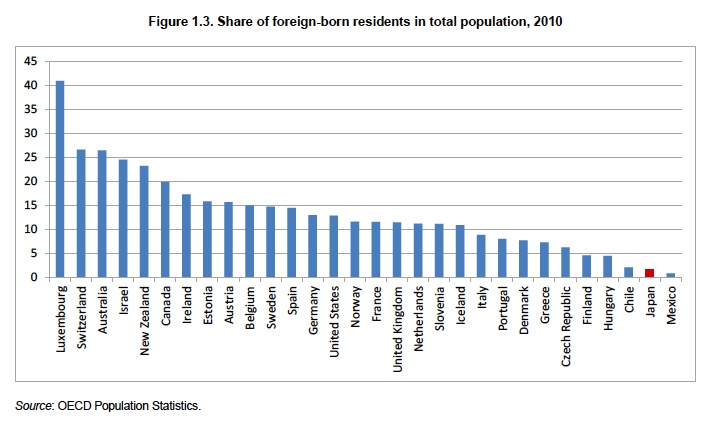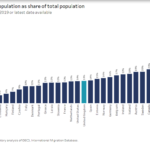Foreign-born residents as a percentage of total population in OECD countries is shown in the chart below. Some countries such as Japan are facing severe labor shortage as the country is facing a shrinking and ageing population. Here is an excerpt from an OECD article:
Japan’s population peaked in 2010 at just over 128 million beginning what is projected to be a sustained and increasingly steep decline. Simultaneously, Japan’s population is ageing rapidly. From 1950 to 2015, the share of population age 65+ grew from just under 5% to over 25%. This is the highest such figure, worldwide. The population aged 80+ has risen even faster, from 0.4% in 1950 to 7.3% in 2013 (OECD average = 4.1%). Japan’s median age was 45.9 years in 2013, compared to a world average of 29 years and an OECD median age of 38.7 for the same year. Based on current projections, the Japanese government expects Japan’s population to decrease by 22-23% between 2010 and 2050, with the elderly (65+ years) accounting for 40% of the population.
Click to enlarge
Source: The case of the shrinking country: Japan’s demographic and policy challenges in 5 charts, OECD Insights
One solutions proposed in the article to solve Japan’s ageing population issue is immigration. Japan is one the few countries in the world with a very low population of immigrants. For the most part Japan is a homogeneous society. Some of the countries with low number of foreigners include Cuba, North Korea, Russia and most East European countries.
According to the OECD, foreign-born population was under 1.7% of the total population in Japan.
OECD countries with high foreign-born population include Luxembourg, Switzerland, Australia, etc. Countries like Australia, New Zealand and Canada have high foreign-born population due to liberal immigration policies.




